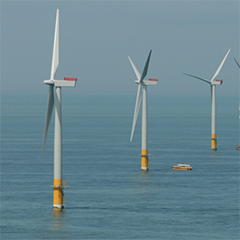Auctions are becoming the standard instrument for granting state support in almost all European markets. In economic terms, this is the right step to take as it subjects renewables to market forces and rewards the most efficient projects. This was evident in the latest UK Government Contract for Difference (CfD) auction round, designed to support renewable energy projects being delivered in UK waters. One of the winners in the latest CfD auction round, September 2017, was innogy’s Triton Knoll offshore wind farm, located off England’s east coast. PES invited Richard Sandford, innogy Director of Offshore Investment & Asset Management, to give us an insight into this offshore project.
‘Triton Knoll’s auction success confirms the excellent work we have done in recent years, and proved that we can successfully hold our own in a very competitive market environment,’ Richard said. ‘Thanks to our extensive know-how in the development as well as the construction and operation of complex offshore projects, as well as our varied research and development activities we have succeeded in further reducing the costs for offshore wind energy in the UK.’
The industry pulling together to reduce costs and drive innovation
innogy’s 860 megawatt Triton Knoll offshore project was allocated a CfD at a price of £74.75 per megawatt hour over 15 years. The project is expected to trigger a capex investment of around £2billion into much needed UK energy infrastructure, with additional investment during the longer operational phase. This will enable the delivery of some of the lowest cost energy generation, with the cost of offshore wind continuing to fall at an unprecedented rate.
‘In the UK, offshore wind is now cheaper than the levelised cost of gas and nuclear according to recent figures released by the Department of Business, Energy and Industrial Strategy,’ Richard said. ‘This shows how economies of scale, increasingly extensive experience of installation and operations, and technological advancements are combining to help drive down costs.’



























